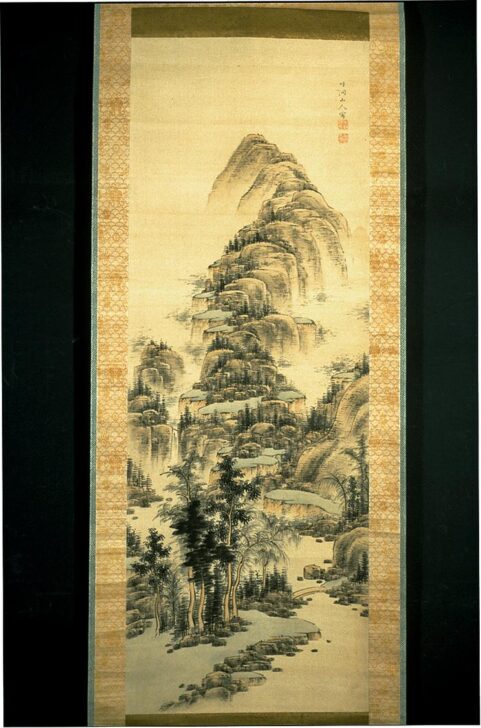Mountain Landscape in Summer
Nakabayashi Chikutō

Description
Like his life-long friend Yamamoto Baiitsu, Chikutô was a native of Nagoya, an important urban center between Kyoto and Edo. The son of a prominent physician, Chikutô began studying painting at age 14, but soon was taken in to the household of the wealthy collector Kamiya Ten’yû, under whose tutelage he was able to view large quantities of first-rate Chinese paintings. It was Ten’yû who gave Chikutô his art name, which means “bamboo cave.” Chikutô and Baiitsu spent several years furthering their studies in Kyoto, where they became good friends with leading scholars in Chinese studies such as Nukina Kaioku and Rai San’yô, both of whom are represented in this exhibition.
Chikutô’s exposure to orthodox Chinese literati painting is very evident in this landscape, where block-like forms are piled up in vertically stacked units. There is a clear self-imposed discipline in the way Chikutô restricts his vocabulary of brushstrokes, confining them to a horizontal-and-vertical grid. The result is a very orderly landscape, revealing more of the artist’s personality than the topography of any site in China or Japan.
Maribeth Graybill, for the exhibition "Japanese Visions of China," 9/21/02 - 1/26/03
Subject Matter:
When he was copying paintings. Chikuto was able to reproduce a great variety of styles, but on his own he was especially fond of the Mi Fu (1051-1107) and Huang Kung-wang (1269-1354) styles. Chikuto had seen many Ming and Ch'ingpaintings that were done in the style of these two early masters. and he formed a fixed idea of these styles and used them frequently throughout his career. Chikuto also made many paintings in which he achieved a fusion of these two styles. From Huang he borrowed a basic landscape structure wherein mountain forms were layered one upon another with the inclusion of many squared off hills and rocks. From the Mi style he adopted the brush technique of short horizontal strokes piled up vertically. This landscape can be included within this last grouping....Some critics of his paintings have felt that his repeated use of certain forms and brush strokes make his work seem mechanical. For Chikuto, limit ing his range of forms, spatial recession, and brushwork, was a device to achieve his ideal of purity. The reserved character of his work often requires repeated viewing for the full flavor of his aesthetic to be appreciated. At its best his work presents us with a light.translucent world of refinement. As a prolific artist whowas one of the most important artists of his day. Chikuto iswell represented in many American collec tions.
Physical Description:
"The composition is classic for Chikuto with a central foreground grouping of trees, a low middle ground area, and a steeply rising series of hills. The large trees have curving trunks outlined by sinuous dry brushwork that is a Chikuto trademark. The varied brushwork in the foliage suggests a wide variety of plants. The soft pastel tints are characteristic of Chikuto's, reserved palette."
Adams, Celeste, and Paul Berry. Heart, Mountains, and Human Ways: Japanese Landscape and Figure Painting: a Loan Exhibition from the University of Michigan Museum of Art. Museum of Fine Arts, 1983.
Usage Rights:
If you are interested in using an image for a publication, please visit https://umma.umich.edu/request-image/ for more information and to fill out the online Image Rights and Reproductions Request Form.